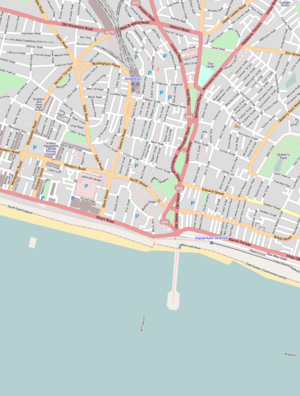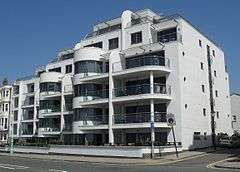Royal Pavilion Tavern
| Royal Pavilion Tavern | |
|---|---|
|
The building from the north–northeast | |
| Location | 7–8 Castle Square, Brighton, Brighton and Hove, United Kingdom |
| Coordinates | 50°49′17″N 0°08′18″W / 50.8214°N 0.1383°WCoordinates: 50°49′17″N 0°08′18″W / 50.8214°N 0.1383°W |
| Built | Early 19th century |
| Restored | 1820 or 1826 |
| Restored by | Amon Henry Wilds |
| Architectural style(s) | Regency |
| Owner | Mitchells & Butlers |
Listed Building – Grade II | |
| Official name: Royal Pavilion Tavern and railings | |
| Designated | 13 October 1952 |
| Reference no. | 1380055 |
 Location within central Brighton | |
The Royal Pavilion Tavern, commonly known as the Pavilion Tavern or Pav Tav,[1] is a pub in the centre of Brighton, part of the English coastal city of Brighton and Hove. Its original name of the Royal Pavilion Hotel indicates its original role; now it is one of the seaside resort's oldest surviving pubs. Converted from a house in the early 19th century, it was also used as a court for several years. Prominent local architect Amon Henry Wilds was responsible for its redesign as a hotel and inn. English Heritage has listed the building at Grade II for its architectural and historical importance, and it stands within a conservation area.
History
The fishing and agricultural village of Brighthelmstone, on the Sussex coast in southeast England, grew into the fashionable resort of Brighton from the mid-18th century. Inward investment, good transport links and the popularity of sea-bathing helped it develop "all of the facilities that would have been expected" of an 18th-century leisure destination.[2] One of the most important was the Castle Inn, converted from a house in 1752 by businessman Samuel Shergold. He recognised that the town's wealthy visitors wanted a focal point near the Old Steine—at that time the centre of Brighton's fashionable life—to meet, socialise and stay. It became the nascent resort's most important social venue, especially after an assembly room and ballroom were added.[3][4][5] Within 50 years, though, it had declined, and it was demolished in 1823. This allowed the junction of North Street and Old Steine to be widened, and it took the name Castle Square.[6][7]
By 1780, North Street was "the principal commercial street in the town", and Castle Square itself became a hub of commercial activity.[8] Despite the decline of the Castle Inn, the area retained its fashionable air,[9] and by the early 19th century a mixed series of buildings had been built on the southern side; despite some later alterations, their layout and essential character remains.[10] One such building was the tall terraced house at number 8. Dating from early in the 19th century,[11] it soon took on a second role. The Court of Whalesbone, a Hundred Court (an early form of magistrates' court moved from the county town of Lewes in 1808 to the building. Sessions were held on Mondays, Wednesdays and Fridays. After short interludes at the Old Ship Hotel and Brighton's original Town Hall, the court sessions returned between 1823 and 1832.[12]
By this time, the building had been converted into the Royal Pavilion Hotel. Described as a "family and commercial hotel", it aimed for middle-class customers who would previously have considered the Castle Inn.[13] It may have been established as early as 1816,[7][14] and certainly by 1820.[13] In that year[7][14] or in 1826, famous local architect Amon Henry Wilds was commissioned to redesign the building. His partner Charles Busby, who worked with him on many buildings in Brighton in the early 19th century, may have assisted him;[13] the pair also worked on 1a Castle Square around the same time.[7] Wilds gave the hotel a typical Regency stuccoed bow front and an intricate balcony featuring the interlinked dolphins which featured on Brighton's coat of arms.[14][13]
The building later changed from a hotel to a conventional inn and took its present name. An early proprietor offended Maria Fitzherbert, the Prince Regent's mistress who lived at Steine House (which backed on to the inn), by putting up a sign on the rear wall which read "Gin Palace". After she complained, he altered it to "Shades"—a local term with a similar meaning.[7] That name was recalled in 1991 when the building was substantially refurbished; part of it was converted into a café-bar and restaurant called Shades. A World War II-era bar counter was retrieved from a pub at London Victoria railway station and installed during this refit.[15] The pub is now owned and operated by the Mitchells & Butlers chain.[16]
The Royal Pavilion Tavern and the iron railings outside it were listed at Grade II by English Heritage on 13 October 1952.[11] This defines it as a "nationally important" building of "special interest".[17] As of February 2001, it was one of 1,124 Grade II-listed buildings and structures, and 1,218 listed buildings of all grades, in the city of Brighton and Hove.[18] It is also within the Valley Gardens Conservation Area,[19] one of 34 conservation areas in the city of Brighton and Hove.[20] This was designated by Brighton Council in 1973 and covers 92.84 acres (37.57 ha).[21]
Architecture
The buildings on the south side of Castle Square are all of a similar age but show a great variety of sizes and styles. The Royal Pavilion Tavern is one of the taller buildings[14] at four storeys in height. The slate-tiled gambrel roof has dormer windows and is partly hidden behind a balustrade which sits on top of a parapet and cornice. The façade is stuccoed and projects as a segmental-arched bow front. The stucco is rusticated at ground-floor level. The entrance is in the rightmost of the three bays and is flanked by granite pilasters topped by brackets with foliage decoration. Above this, an iron balcony runs across the full width of the building at first-floor level; this dates from the late 19th century[11] and has finials in the form of interlinked dolphins and crowns, recalling the Borough of Brighton's emblem.[14][13] Each storey has three windows, but they are treated in various ways; those at first-floor level have architraves, the second-storey windows have a small individual iron balcony with anthemion decoration; and those on the top floor have prominent sills.[11]
References
Notes
- ↑ "Royal Pavilion Tavern". ViewBrighton (2 View (UK) LLP). 2013. Archived from the original on 7 April 2013. Retrieved 7 April 2013.
- ↑ Berry 2002, p. 98.
- ↑ Musgrave 1981, pp. 214–215.
- ↑ Collis 2010, pp. 50–51.
- ↑ Berry 2002, p. 103.
- ↑ Musgrave 1981, p. 214.
- 1 2 3 4 5 Collis 2010, p. 51.
- ↑ "Valley Gardens Conservation Area Study and Enhancement Plan" (PDF). Brighton & Hove City Council (Design & Conservation Department). 13 September 1995. p. 10. Archived from the original on 31 July 2013. Retrieved 31 July 2013.
- ↑ "Valley Gardens Conservation Area Study and Enhancement Plan" (PDF). Brighton & Hove City Council (Design & Conservation Department). 13 September 1995. p. 5. Archived from the original on 31 July 2013. Retrieved 31 July 2013.
- ↑ "Valley Gardens Conservation Area Study and Enhancement Plan" (PDF). Brighton & Hove City Council (Design & Conservation Department). 13 September 1995. p. 9. Archived from the original on 31 July 2013. Retrieved 31 July 2013.
- 1 2 3 4 Historic England. "Royal Pavilion Tavern and railings, 7–8 Castle Square, Brighton (Grade II) (1380055)". National Heritage List for England. Retrieved 1 August 2013.
- ↑ D'Enno 2007, p. 41.
- 1 2 3 4 5 Musgrave 1981, p. 217.
- 1 2 3 4 5 Antram & Morrice 2008, p. 81.
- ↑ Collis 2005, p. 59.
- ↑ "Terms of use". The Royal Pavilion Tavern in Brighton/Mitchells & Butlers. 2013. Archived from the original on 1 August 2013. Retrieved 1 August 2013.
- ↑ "Listed Buildings". English Heritage. 2012. Archived from the original on 24 January 2013. Retrieved 24 January 2013.
- ↑ "Images of England – Statistics by County (East Sussex)". Images of England. English Heritage. 2007. Archived from the original on 27 December 2012. Retrieved 27 December 2012.
- ↑ "Conservation Areas street directory – N". Brighton & Hove City Council. 2012. Archived from the original on 8 February 2013. Retrieved 8 February 2013.
- ↑ "Conservation Areas in Brighton & Hove". Brighton & Hove City Council (Design & Conservation Department). 2010. Archived from the original on 20 January 2013. Retrieved 1 January 2012.
- ↑ "Valley Gardens Conservation Area". Brighton & Hove City Council. 2012. Archived from the original on 8 February 2013. Retrieved 8 February 2013.
Bibliography
- Antram, Nicholas; Morrice, Richard (2008). Brighton and Hove. Pevsner Architectural Guides. London: Yale University Press. ISBN 978-0-300-12661-7.
- Berry, Sue (2002). "Myth and Reality in the Representation of Resorts: Brighton and the Emergence of the "Prince and Fishing Village" Myth 1770–1824" (PDF). Sussex Archaeological Collections. Lewes: Sussex Archaeological Society. 140: 97–112. Archived from the original on 1 August 2013. Retrieved 1 August 2013.
- Collis, Rose (2005). Brighton Boozers: a History of the City's Pub Culture. Brighton: Brighton & Hove City Council (Royal Pavilion, Libraries and Museums Department). ISBN 0-948-72360-2.
- Collis, Rose (2010). The New Encyclopaedia of Brighton. (based on the original by Tim Carder) (1st ed.). Brighton: Brighton & Hove Libraries. ISBN 978-0-9564664-0-2.
- D'Enno, Douglas (2007). Brighton Crime & Vice 1800–2000. Barnsley: Wharncliffe Books. ISBN 1-845630-30-0.
- Musgrave, Clifford (1981). Life in Brighton. Rochester: Rochester Press. ISBN 0-571-09285-3.

.jpg)
.jpg)
